Barber J.R. Intermediate Mechanics of Materials
Подождите немного. Документ загружается.


9.4 The governing equation 425
The attentive reader should immediately recognize this equation as having the
same form as equation (7.5) for the bending of a beam on an elastic foundation. To
understand the reason for this similarity, it might be helpful to regard the shell as a
set of strips, as shown in Figure 9.5. Each strip can be considered as an elastic beam
whose displacement in the radial direction is opposed by the elastic action of the
circumferential stress
σ
2
.
All of the solution methods
2
developed in Chapter 7 can be applied to the solution
of equation (9.20). However, the most important conclusion to be drawn from this
equation, as in §7.3, is that the displacement due to radial loading of the shell will be
localized, decaying exponentially with distance from the load. As before, we define
a characteristic decay length
l
0
=
1
β
= C
√
at , (9.22)
where the numerical factor
C =
4
s
1
3(1 −
ν
2
)
(9.23)
lies in the very restricted range 0.76<C<0.82 for 0<
ν
<0.5. Thus, the characteristic
length is significantly smaller than the radius a, since t ≪a. As an example, a steel
shell of radius 1 m and wall thickness 10 mm will have a characteristic length of 55
mm.
It follows that all practical shells are ‘long’ in the sense of Chapter 7 and can
therefore be analyzed using the infinite or semi-infinite solutions of §§7.4, 7.2.1.
An alternative form for the right hand side of equation (9.20) can be obtained by
noting that the membrane theory predicts that the circumferential stress
σ
2
= pa/t
for the cylinder and hence the predicted membrane displacement is
u
m
r
=
(
σ
2
−
νσ
1
)a
E
=
pa
2
Et
−
νσ
1
a
E
,
using (8.5). We can substitute this result into (9.20), obtaining
d
4
u
r
dz
4
+ 4
β
4
u
r
= 4
β
4
u
m
r
. (9.24)
This shows that the membrane solution (8.5) gives the exact value for the radial
displacement
3
as long as the loading is a polynomial of third degree or below in z.
2
Readers who have not studied Chapter 7 will find it helpful to review §§7.2–7.5 in parallel
with the present derivations.
3
A similar result holds for a beam on an elastic foundation subjected to polynomial loading
and corresponds to the case where u=w(z)/k and the loading is transmitted directly to the
foundation.

426 9 Axisymmetric Bending of Cylindrical Shells
9.4.1 Solution strategy
The first stage in the analysis of any axisymmetric shell is to find the ‘membrane so-
lution’, using the methods of Chapter 8. We can then identify the regions of the shell
(typically the ends of the shell or discontinuities of radius, thickness or loading) at
which the membrane theory predicts discontinuities of radial displacement or slope.
The bending theory is then used to construct a local solution, treating the shell as
infinite or semi-infinite.
The equilibrium equation used to determine the meridional membrane stress
σ
1
is unaffected by the presence of local bending, so this value carries over into the
bending calculation. By contrast, equation (8.2) is modified by the presence of shear
forces [see equation (9.15) above] and hence the circumferential stress
σ
2
gener-
ally deviates from the value predicted by the membrane theory in a region of local
bending. However, once
σ
1
is determined, we can solve (9.20) or (9.24) for u
r
with
appropriate end conditions. The local value of
σ
2
can then be recovered from equa-
tion (9.17).
It is convenient to summarize these steps as follows:-
(i) Find the axial membrane stress
σ
1
as in §8.1 by making a cut perpendicular to
the axis, writing an equilibrium equation, and summing forces along the axis.
(ii) Use this result and the internal pressure p to determine the right-hand side of
equation (9.20), which may be a function of z.
(iii) Use the techniques of Chapter 7 to obtain the general solution of equation
(9.20), noting that for uniform or low order polynomials we can find a sim-
ple particular solution and that the homogeneous solution is defined by equa-
tion (7.11) or (7.12). Usually the shell can be considered semi-infinite, so we
only need the exponentially decaying terms and these can be written in the form
(7.18).
(iv) Find the constants from the end conditions, using (9.13, 9.19) if necessary to
convert force or moment end conditions to conditions on u
r
.
(v) Once u
r
is known,
σ
2
can be determined from (9.17).
(vi) The bending moment M
z
is given by (9.13) and the maximum stresses are then
given by
σ
max
z
=
σ
1
±
6M
max
z
t
2
;
σ
max
θ
=
σ
2
±
6
ν
M
max
z
t
2
. (9.25)
Example 9. 1
A cylindrical steel tube of mean diameter 50 mm and wall thickness 4 mm is built in
to a rigid wall at one end and loaded by an axial force of 60 kN, as shown in Figure
9.6. Find the maximum tensile stress in the tube. There is no internal pressure and
the elastic properties for steel are E =210 GPa,
ν
=0.3.
The axial load of 60 kN will produce a meridional stress
σ
1
given by the equilib-
rium equation
π
×50 ×4 ×
σ
1
= 60 ×10
3
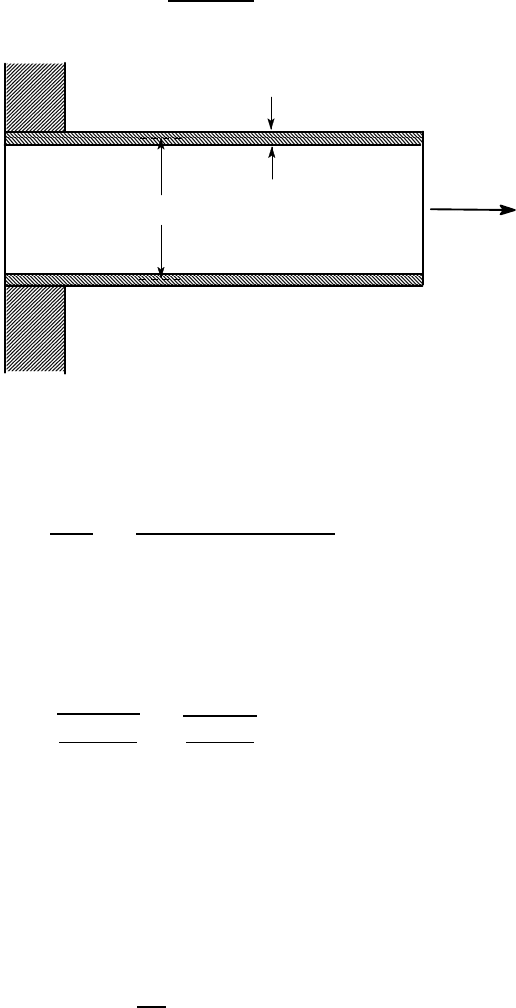
9.4 The governing equation 427
and hence
σ
1
=
60 ×10
3
π
×50 ×4
= 95.5 MPa .
Figure 9.6
The membrane solution gives
σ
2
= 0, from equation (8.2), since there is no in-
ternal pressure and R
1
= ∞ for the cylinder. Thus the membrane radial displacement
will be
u
m
r
= −
νσ
1
a
E
= −
0.3 ×95.5 ×10
6
×0.025
210 ×10
9
= −3.41 ×10
−6
m .
The negative sign indicates that the displacement is radially inwards — the diameter
of the tube gets smaller as a result of Poisson’s ratio strains.
This radial displacement is prevented at the built-in support, where u
r
= 0 and
du
r
/dz= 0. There will therefore be a region of local bending.
We first calculate
β
=
4
r
3(1 −
ν
2
)
a
2
t
2
=
4
r
3 ×0.91
25
2
×4
2
= 0.129 mm
−1
(129 m
−1
) ,
corresponding to a characteristic length, l
0
=7.78 mm.
The membrane displacement u
m
r
is constant (independent of z) and hence a suit-
able particular integral of equation (9.24) is u
r
= u
m
r
. A sufficiently general solution
of this equation can therefore be written
u
r
= u
m
r
+ B
3
f
1
(
β
z) + B
4
f
2
(
β
z) ,
using equation (7.18) from §7.2 for the homogeneous solution. The corresponding
derivative is
θ
(z) ≡
du
r
dz
= −B
3
β
f
3
(
β
z) + B
4
β
f
4
(
β
z) ,
4 mm
50 mm
60 kN
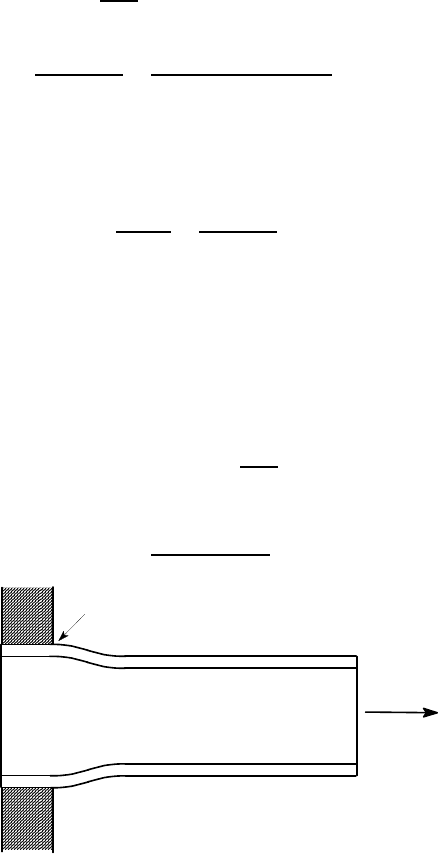
428 9 Axisymmetric Bending of Cylindrical Shells
from (7.19) and the boundary conditions u
r
=du
r
/dz= 0 therefore require that
B
3
= −u
m
r
; −B
3
+ B
4
= 0 ,
with solution
B
3
= B
4
= 3.41 ×10
−6
m .
The bending moment M
z
is given by equation (9.13, 7.23) as
M
z
= −D
d
2
u
r
dz
2
= −2D
β
2
[B
3
f
2
(
β
z) −B
4
f
1
(
β
z)] ,
where
D =
Et
3
12(1 −
ν
2
)
=
210 ×10
9
×4
3
×10
−9
12 ×0.91
= 1230 Nm .
The maximum value of M
z
occurs at z=0 and is
M
max
z
= 2D
β
2
B
4
= 2 ×1230 ×129
2
×3.41 ×10
−6
= 138.6 Nm per m .
The corresponding maximum bending stress is
σ
max
=
6M
max
z
t
2
=
6 ×138.6
4
2
= 52.0 MPa.
This stress is additive to the membrane stress
σ
1
=95.5 MPa. The deformed shape
of the tube is as shown in Figure 9.7, from which we conclude that the maximum
tensile stress (the most extended fibres) occur at the outside of the shell near z = 0,
since this is the outer radius of the curvature in the cross-sectional view. At this point,
we have
σ
zz
= 95.5 + 52.0 = 147.5 MPa .
Alternatively, we can use equation (9.5) to obtain
σ
zz
=
σ
1
+
M
z
η
t
3
,
noting that M
z
is positive, to determine the maximum stress to be at
η
=t/2, where
σ
zz
= 95.5 +
12 ×138.6 ×2
4
3
= 147.5 MPa .
60 kN
maximum tensile stress
Figure 9.7: Deformed shape of the tube
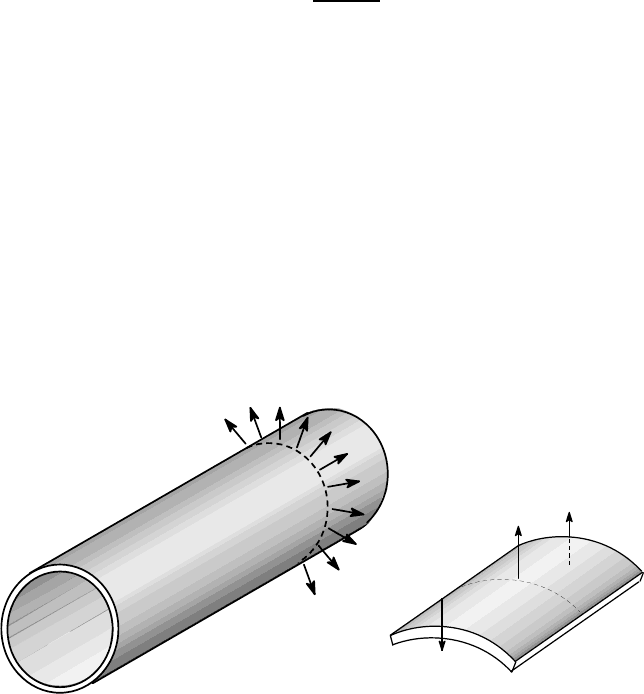
9.5 Localized loading of the shell 429
A bending moment M
θ
will also be induced in the circumferential direction and
in some situations this can define the maximum tensile stress, when combined with a
substantial circumferential membrane stress
σ
2
. We first calculate
σ
2
, using equation
(9.17). At the support, u
r
=0 and we have
σ
2
=
νσ
1
= 0.3 ×95.5 = 28.7 MPa .
The circumferential bending moment at the support is found from equation (9.8) as
M
max
θ
=
ν
M
max
z
= 0.3 ×138.6 = 41.6 Nm per m
and hence
σ
max
θθ
= 28.7 +
6 ×41.6
4
2
= 44.3 MPa .
Once again, the maximum occurs at the outer surface of the shell, but it is smaller
than
σ
max
zz
.
9.5 Locali zed loading of the shell
Figure 9.8 (a) shows a cylindrical shell subjected to an axisymmetric radial load,
F
0
per unit circumference. This problem is exactly analogous to the infinite beam
problem of §7.4 and we conclude by analogy with equation (7.35) that the radial
displacement will be given by
u
r
=
δ
f
3
(
β
|z|) , (9.26)
where
δ
is the displacement under the load.
0
F per unit circumference
0
F a δθ
-
V(0 ) a δθ
V(0 ) a δθ
+
(a) (b)
Figure 9.8: (a) Cylindrical shell subjected to an axisymmetric radial load; (b) Equi-
librium of a shell element

430 9 Axisymmetric Bending of Cylindrical Shells
To find the relation between F
0
and
δ
, we note that
V = −D
d
3
u
r
dz
3
= −4D
δβ
3
f
1
(
β
|z|)sgn(z) ,
from equations (9.19, 9.26, 7.23), where sgn(z)=1 for z>0 and −1 for z <0. Figure
9.8 (b) shows a small element of shell including the load F
0
and we conclude that
F
0
= −V (0+) +V(0−) = 8
β
3
D
δ
,
which permits us to rewrite (9.26) in the form
u
r
=
F
0
8
β
3
D
f
3
(
β
|z|) . (9.27)
The corresponding axial bending moment, M
z
is
M
z
= −D
d
2
u
r
dz
2
=
F
0
4
β
f
4
(
β
|z|) . (9.28)
As in §7.4.1, we can generalize these results by superposition to obtain the solu-
tion for an arbitrary axisymmetric load acting over the segment a< z <b. We obtain
u
r
=
1
8
β
3
D
Z
b
a
p(z
′
) f
3
(
β
|z −z
′
|)dz
′
(9.29)
M
z
=
1
4
β
Z
b
a
p(z
′
) f
4
(
β
|z −z
′
|)dz
′
, (9.30)
where we note that a distributed axisymmetric load is equivalent to an internal pres-
sure p that is a function of the axial coordinate z
′
.
9.6 Shell transition regions
One of the most important applications of the shell bending theory concerns the
design of transitions between different shell segments. We saw in §8.5.1 that the
membrane theory predicts a discontinuity in radial displacement u
r
whenever there
is a discontinuity in the radius R
1
, and the reconciliation of this discontinuity always
involves local bending.
Strictly speaking, the theory developed in this chapter applies only to cylindri-
cal shells and hence can only be used for the cylindrical segment, for example, in
the cylinder/sphere transition of Figures 8.21, 8.22. There is a distinct and rather
more complicated theory for the bending of spherical shells.
4
The results are broadly
similar to those for the cylinder (bending effects are localized and decay away from
the loaded region), but the functions are affected by the fact that the shell becomes
4
See for example, S.P. Timoshenko and S. Woinowsky-Krieger (1959), Theory of Plates and
Shells, McGraw-Hill, New York, 2nd edn., §§129–132.
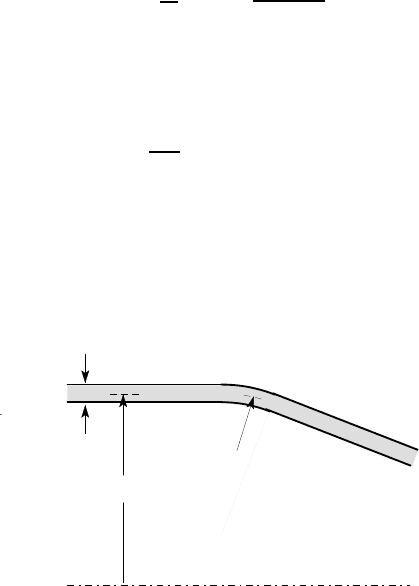
9.6 Shell transition regions 431
locally inclined to the axis and has a cross-sectional radius r, which varies with dis-
tance from the loaded region.
However, we have seen that shell bending effects are extremely localized near
the discontinuity and in many cases these complicating factors do not reach signif-
icant proportions within the decay length, permitting the cylindrical shell bending
theory to be used as an approximation. The appropriateness of this approximation
can be assessed by calculating the characteristic length from equation (9.22) and de-
termining the change in radius and shell inclination at the end of the bending zone.
For example, Figure 9.9 shows a toroidal shell segment connecting a cylinder and a
cone. The decay length in the cylinder is
l
0
= 0.78
√
at = 0.78
√
500 ×10 = 55 mm .
The region affected by bending is therefore of the order of 55 mm to each side of the
transition between the cylindrical and toroidal segments. On the toroidal side, the
angle subtended at the centre O
1
is therefore
α
=
55
100
= 0.55 radians = 31.6
o
and the change in cross-sectional radius, r in this range is
100(1 −cos31.6
o
) = 14.8 mm .
Thus, in this region, the toroidal segment is sufficiently close to a cylinder to justify
the use of the cylindrical bending theory, at least to obtain a first approximation to
the magnitude of the bending stresses.
500 mm
100 mm
10 mm
.
O
1
Figure 9.9: Transition from a cylinder to a toroidal shell segment
To determine the bending stresses associated with a transition between two shell
segments, we first calculate the membrane stresses and displacements to determine
the discontinuity in u
r
predicted at the transition. The reconciliation of this disconti-
nuity is then effected by applying equal and opposite forces and moments to the two
segments, as in Example 7.3. As in that case, the maximum bending moment occurs
at the two points
β
z= ±
π
/4.
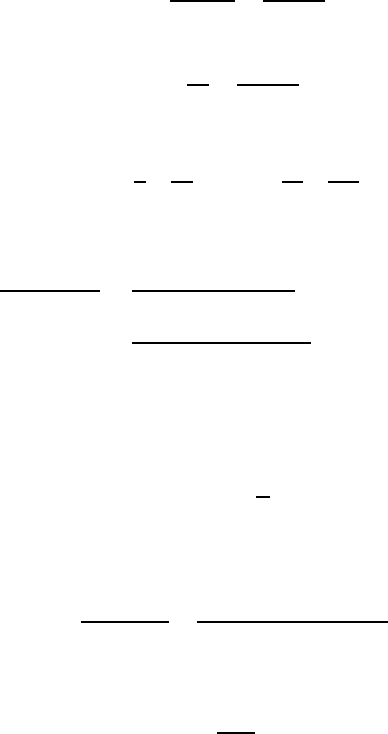
432 9 Axisymmetric Bending of Cylindrical Shells
Example 9. 2
Find the maximum tensile and compressive stresses for the toroidal to cylindrical
transition of Figure 9.9, if the internal pressure is 2 MPa.
We first calculate the membrane stresses and displacements. For both toroidal
and cylindrical segments at the transition, we have
σ
1
=
p ×
π
a
2
2
π
at
=
2 ×500
2 ×10
= 50 MPa .
For the cylinder,
σ
2
=
pa
t
=
2 ×500
10
= 100 MPa ,
whereas for the toroidal segment (R
1
=100 mm, R
2
=500 mm),
σ
2
= R
2
p
t
−
σ
1
R
1
= 500
2
10
−
50
100
= −150 MPa .
The membrane displacements are
u
m
r
=
(
σ
2
−
νσ
1
)a
E
=
(100 −0.3 ×50)500
210 ×10
3
= 0.202 mm (cylinder)
=
(−150 −0.3 ×50)500
210 ×10
3
= −0.393 mm (toroidal segment) .
The bending solution must therefore reconcile a discontinuity
δ
=0.202+0.393=
0.595 mm in u
r
, half of which will be accommodated on each side of the transition.
The bending moment will be zero at the transition and hence the bending displace-
ment will be
u
b
r
=
δ
2
f
1
(
β
z) ,
by analogy with equation (7.24), where
β
= 1/l
0
= 18.2 m
−1
(the value of l
0
= 55
mm was calculated above). The stiffness of the shell is
D =
Et
3
12(1 −
ν
2
)
=
210 ×10
9
×10
3
×10
−9
12 ×0.91
= 19,230 Nm
and the axial bending moment is therefore
M
z
= −D
d
2
u
r
dz
2
= −D
δβ
2
f
2
(
β
z) .
The maximum value of this expression occurs at
β
z=
π
/4 and is
M
max
z
= 0.322D
δβ
2
= 0.322 ×19,230 ×0.595 ×10
−3
×18.2
2
= 1258 Nm per m .
The corresponding maximum bending stress is

9.6 Shell transition regions 433
σ
=
6M
max
z
t
2
=
6 ×1258
10
2
= 75.5 MPa ,
giving a maximum axial stress
σ
max
zz
= 50 + 75.5 = 125.5 MPa .
We should also check to ensure that the circumferential stress
σ
θθ
nowhere ex-
ceeds this maximum value. We recall that the circumferential membrane stress
σ
2
=
Eu
r
a
+
νσ
1
,
from equation (9.17). For most of the shell, this will be lower than the limiting value
of 100 MPa in the cylindrical segment, since the transition restrains the shell from ex-
pansion. However, the oscillatory nature of the decaying function f
1
(x) ensures that
there is an axial location at which u
r
> u
m
r
and hence
σ
2
> 100 MPa. The maximum
u
r
will occur where
θ
(z) =
β δ
2
f
3
(
β
z) = 0
and hence cos(
β
z)+sin(
β
z) = 0. The first solution of this equation is at
β
z = 3
π
/4,
where
u
b
r
= −
δ
2
f
1
3
π
4
= −
0.595 ×(− 0.067)
2
= 0.020 mm .
We therefore have,
σ
max
2
=
210 ×10
3
(0.202 + 0.020)
500
+ 0.3 ×50 = 108.2 MPa .
In addition, the circumferential bending moment at this point is
M
θ
=
νβ
2
D f
2
3
π
4
= 0.3×19,230×0.595×10
−3
×18.2
2
×0.067 = 76 Nm per m ,
contributing an additional stress
σ
b
θθ
=
6 ×76
10
2
= 4.6 MPa .
However, it is clear that the maximum tensile stress in the shell is the axial stress
σ
max
zz
=125 MPa.
9.6.1 The cy linder/cone transition
The toroidal shell of Example 9.2 is often used to form a transition between a cylin-
drical and a conical shell segment, as shown in Figure 9.10. In this section, we shall
discuss the criteria that might be used to determine an appropriate transition radius,
R.
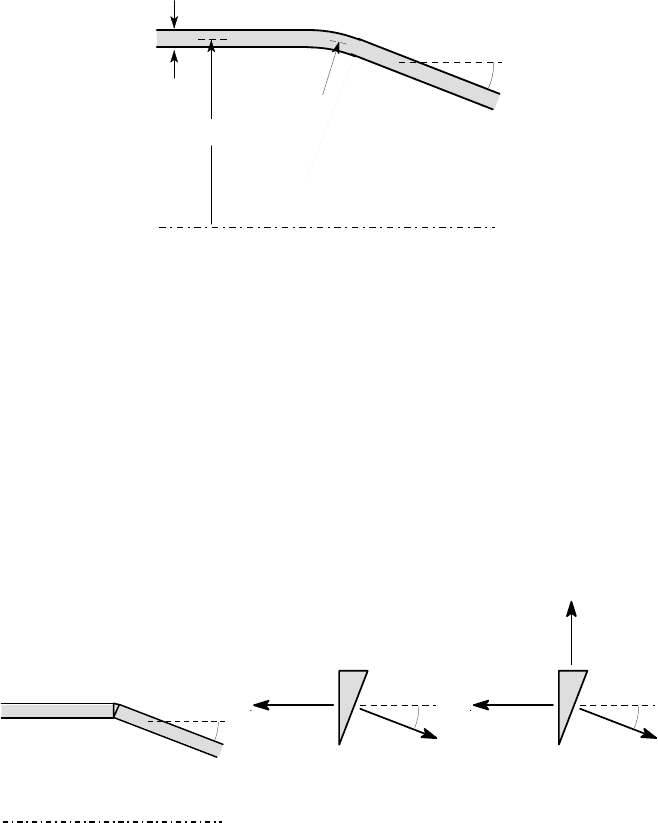
434 9 Axisymmetric Bending of Cylindrical Shells
.
O
1
a
t
R
α
Figure 9.10: Toroidal transition from a cylinder to a cone
If R is small, the circumferential membrane stress
σ
2
will be negative (compres-
sive) in the toroidal segment and the displacement discontinuity
δ
to be reconciled
by bending will be relatively large. In this case, the largest tensile stress in the shell
will be the axial stress
σ
zz
, as in Example 9.2, and it will be dominated by the bending
term 6M
z
/t
2
.
Increasing R will reduce the bending stresses, but the total stress cannot be lower
than the membrane stresses
σ
1
,
σ
2
and these are dominated by the circumferential
stress
σ
2
in the cylindrical and conical segments. Thus, there is nothing to be gained
by increasing R beyond the point at which the maximum total axial stress is equal
to the largest value of
σ
2
. Depending on the semi-angle of the cone, this break-even
point occurs in the range R/a= 0.5 ∼0.6 (see Problem 9.7).
α
F
0
α
cone
σ
1
t
cylinder
σ
1
t
α
cone
σ
1
t
cylinder
σ
1
t
(a) (b) (c)
Figure 9.11: (a) Abrupt cylinder/cone transition; (b) loading of the connecting ele-
ment; (c) Equilibrium restored by a radial force
At the other extreme, we could make an abrupt transition from the cylinder to the
cone, as shown in Figure 9.11 (a). In this case, the small triangular element connect-
ing the segments will be subject to the loading shown in Figure 9.11 (b) and it cannot
be in equilibrium. The meridional stresses are calculated in the usual way as
